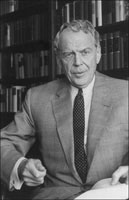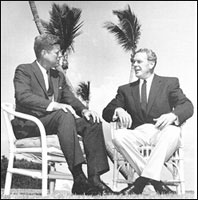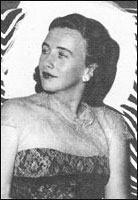John F. Kennedy married Jackie Bouvier in 1952. Previous to that time he was married to Durie Malcolm–a twice divorced Palm Beach socialite. According to Latin Church canon law, that marriage was invalid because it was not performed by a priest in front of two or three witnesses. Here is the dogmatic Council of Trent statement on marriage:
According to Latin Church canon law, the only President of the United States who was legally married was Jack Kennedy. Additionally, the Council of Trent defines marriage as one MAN and one WOMAN:
Clark Clifford was a very prominent lawyer and special counsel to President Kennedy. In 1961, he was summoned to the White House because of the discovery that the President had a previous wife.
The Blauvelts were a Dutch family who came to the New World in 1638. A descendant, Louis L. Blauvelt, made a family genealogy which had an account of a family member, Durie Malcolm, marrying Jack Kennedy in 1947.
It's a small world after all and President Kennedy must have been shocked when he found out that Clark Clifford actually knew his former wife!! The Blauvelt Affair by Clark Clifford
President Kennedy told me that a story had been circulating that he had been secretly married when he was younger to a woman named Durie Malcolm. The rumors were based upon a privately printed book, a genealogy of all the descendants of a seventeenth-century Dutch Hudson Valley settler named Blauvelt; it had been compiled over twenty years by a retired General Electric toolmaker in New Jersey named Louis L. Blauvelt, who finished his work in 1957, and died two years later at the age of seventy-nine. Fewer than one thousand copies of the book had been printed, but one was on file at the Library of Congress. In the late summer of 1961, an unknown person had photocopied and mailed to several reporters page 884 of this obscure book, which contained the following passage:
At first, in the summer of 1961, President Kennedy and his staff had tried to deal with the matter by ignoring it; but when the rumor continued to circulate and then surfaced in a few minor periodicals, the President called me. When I asked him what the facts were, he replied, "All I know is that some years ago, I knew very briefly a young woman named Durie Malcolm. I think I had two dates with her. One may have been a dinner date in which we went dancing. The other, to my recollection, was a football game. Those were the only two times I ever saw her. My brother Joe also dated her a few years earlier. I remember that she was quite attractive." My
response startled him, as I knew it would: "I'll go further than
that, Mr. President. I think she was one of the most attractive women
I ever met" He was amused at this striking coincidence, but he was less amused at the fact that the extract from Blauvelt's genealogy was beginning to circulate widely among right-wing and anti-Catholic circles throughout the nation–with several hundred thousand copies of the item being distributed by bigoted opponents. So far it had not appeared in print in any serious or responsible publication. But the President showed me a "blind" item from a recent issue of Roll Call, a publication for Capitol Hill employees, that asked, "Who is the former Senator, now in high public office, who is concealing his former marriage?" The President asked me to deal only with him, his brother, and Press Secretary Pierre Salinger. I went to the Library of Congress that same day to see for myself the Blauvelt genealogy. It was a tiny item in a huge book that contained virtually nothing but names. There was no evidence that the author had noticed that the man mentioned in the item about Durie was already a United States Senator at the time of publication. Next, I located Durie Malcolm Desloge Shevlin in Palm Beach and called her up. She was surprised to hear from me again. It had been a long time since we had last seen each other in St. Louis, but she said she had followed my career from time to time. I said I needed to talk to her about President Kennedy: "I want to read to you an item from a book about the genealogy of the Blauvelt family that states that you and President Kennedy were married." I
could hear her laugh. "Good God," she said, "imagine
being married to President Kennedy. That's a laugh." I told her I would report all this back to the President, and we would look for ways to stop the story from spreading any further. She said she did not wish to deal with reporters and would refuse to take their calls, but that we were free to state that she had denied the story if we wanted to do so. I asked her if she would sign an affidavit stating that she had never been married to John F. Kennedy, and she readily agreed. Throughout the rest of the year, the story continued to circulate without appearing in a major publication. In May 1962, The Thunderbolt, which described itself on its masthead as "the official white racial organ of the National States Rights party," ran the item from Blauvelt's book, and accused the national press of suppressing the story. A right-wing business executive in Massachusetts mailed copies of the story to a list of selected "patriots." In growing numbers, letters began arriving at the White House, asking about the story. The White House replied with a form letter pointing out several gross errors of fact in the genealogy. But, hoping not to give the story any further dissemination, the President and Salinger resisted making any public statement. Rumors, however, do not have to be true in order to survive. On September 2, 1962, Parade, the nationally distributed Sunday newspaper supplement, printed a letter from a reader in its widely read column, "Walter Scott's Personality Parade," written by Lloyd Shearer, asking if the rumor that the President had been married before was true. In telling his readers that the story was false, "Walter Scott" was, of course, disseminating it widely for the first time. And on the same day the British press reported the story. These two press items convinced the President that he had to take rapid action. In order to "control" the story, he invited his closest friend in the press corps, Benjamin Bradlee, then the Newsweek bureau chief in Washington, to print the story in the form of a false rumor revealed, denied, and hopefully buried. At the President's request, I recounted to Ben my involvement in the story. Newsweek's story, in the September 24, 1962 issue, said that the magazine had been aware of the rumor since August 1961, and had found it completely false, but that it had created an "acute" problem for the President as it continued to be widely circulated "by extremist groups ... for political purpose." The Newsweek story was picked up by the rest of the national press, and was the talk of Washington for a week or so. As the Kennedys had hoped, though, once the falsehood had been exposed to public light, it was reduced to a curious footnote to the Kennedy legend. I remain to this day convinced that the entire affair was nothing more than the result of an error made by an old man who was not careful in checking his facts. I doubt that it would ever have received much attention had it not been for the intense interest and continual rumors swirling around the personal life of President Kennedy and the entire Kennedy family. (Clifford, Counsel to the President, pp. 371-374). Editor's Note Clifford should have advised Durie Malcolm to sue for millions . . . if she could prove that the story was a fabrication. However, she did speak a half-truth, because, under Latin Church canon law, she was not really married to JFK. Vital links Reference Clifford, Clark, & Holbrooke, Richard. Counsel to the President: A Memoir. Random House, New York, 1991.
|



